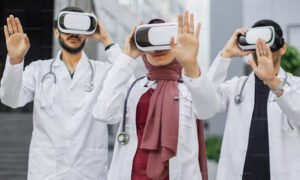Virtual Reality in Healthcare: Therapy and Medical Training

Virtual reality (VR) is an immersive technology that allows users to interact with a simulated environment. In recent years, VR has gained significant traction in various fields, including healthcare. The potential applications of VR in healthcare are vast and varied, ranging from therapy to medical training. This comprehensive guide explores the innovative ways VR is transforming healthcare, focusing on its use in therapy and medical training.
Understanding Virtual Reality
What is Virtual Reality?
Virtual reality is a technology that creates a simulated environment, allowing users to immerse themselves in a three-dimensional, computer-generated world. Users typically engage with VR through specialized headsets that provide visual and auditory feedback, often complemented by haptic devices that offer tactile sensations.
How Does Virtual Reality Work?
VR systems use various sensors and input devices to track the user’s movements and adjust the virtual environment accordingly. This creates a sense of presence, making users feel as though they are physically present in the virtual world. Key components of a VR system include:
- Head-Mounted Displays (HMDs): These devices, worn on the head, contain screens that display the virtual environment.
- Motion Trackers: Sensors track the user’s head and body movements to update the visual display in real time.
- Input Devices: Controllers, gloves, and other devices allow users to interact with the virtual environment.
Virtual Reality in Therapy
Pain Management
Distraction Techniques
VR has shown promise in managing acute and chronic pain through distraction techniques. By immersing patients in engaging virtual environments, VR can divert their attention away from pain, reducing their perception of discomfort. Studies have shown that VR can be effective in reducing pain during medical procedures, such as wound care and dental treatments.
Mechanisms of Pain Relief
The pain-relieving effects of VR are thought to be due to its ability to engage multiple senses and capture a significant portion of the brain’s attention. This leaves less cognitive capacity available for processing pain signals. Additionally, VR can induce relaxation and reduce anxiety, further contributing to pain relief.
Mental Health Treatment
Exposure Therapy
Exposure therapy is a common treatment for anxiety disorders, such as phobias and post-traumatic stress disorder (PTSD). VR enables controlled exposure to feared stimuli in a safe and controlled environment. For example, patients with a fear of heights can gradually confront their fear by navigating virtual high places, helping them to desensitize and reduce their anxiety over time.
Cognitive Behavioral Therapy (CBT)
VR can enhance cognitive behavioral therapy by providing immersive scenarios for patients to practice coping strategies. For instance, patients with social anxiety can engage in virtual social interactions, allowing them to practice skills and build confidence in a controlled setting.
Treatment of PTSD
For individuals with PTSD, VR offers a unique approach to therapy by enabling them to confront and process traumatic experiences in a safe and controlled environment. This process, known as VR-assisted prolonged exposure therapy, has shown promise in reducing PTSD symptoms.
Physical Rehabilitation
Motor Skill Training
VR can be used to facilitate motor skill training and physical rehabilitation for patients recovering from injuries or surgeries. Virtual environments can be designed to simulate real-world tasks, allowing patients to practice movements and improve their motor skills in a motivating and engaging way.
Telerehabilitation
Telerehabilitation involves providing rehabilitation services remotely using technology. VR can play a significant role in telerehabilitation by enabling therapists to deliver personalized rehabilitation programs to patients in their own homes. This approach can increase accessibility and adherence to rehabilitation programs.
Cognitive Rehabilitation
Memory Training
VR can be used to create environments that simulate real-life situations, helping patients with cognitive impairments to practice and improve their memory skills. For example, patients with Alzheimer’s disease can navigate virtual environments designed to enhance their spatial memory and cognitive function.
Attention and Executive Function Training
Cognitive rehabilitation programs using VR can target attention and executive function skills. Patients can engage in virtual tasks that require sustained attention, problem-solving, and decision-making, helping to improve these cognitive abilities over time.
Pediatric Therapy
Distraction During Procedures
VR can be particularly effective in pediatric therapy by providing engaging and immersive experiences that distract children during medical procedures. For example, children undergoing chemotherapy can be immersed in a virtual world, reducing their anxiety and discomfort.
Treatment of Developmental Disorders
VR can also be used to support therapy for children with developmental disorders, such as autism spectrum disorder (ASD). Virtual environments can be designed to teach social skills, communication, and daily living skills in a safe and controlled setting.
Virtual Reality in Medical Training
Surgical Training
Simulation of Surgical Procedures
VR offers a valuable tool for surgical training by providing realistic simulations of surgical procedures. Trainees can practice complex surgeries in a virtual environment, gaining valuable experience without the risk to real patients. This hands-on practice can improve surgical skills and confidence.
Error Reduction
By allowing trainees to practice and refine their skills in a virtual environment, VR can help reduce errors in real surgeries. Trainees can repeat procedures multiple times, learning from their mistakes and improving their techniques.
Anatomy Education
Interactive 3D Models
VR can enhance anatomy education by providing interactive 3D models of the human body. Students can explore and manipulate these models, gaining a deeper understanding of anatomical structures and their spatial relationships. This immersive approach can enhance learning and retention.
Virtual Dissection
Virtual dissection allows students to explore the human body in a detailed and realistic manner without the need for cadavers. VR can simulate the process of dissection, providing an ethical and accessible alternative to traditional dissection methods.
Emergency Response Training
Simulated Emergency Scenarios
VR can be used to create realistic emergency scenarios for training healthcare professionals in emergency response. Trainees can practice responding to various emergencies, such as cardiac arrest or trauma cases, in a controlled and safe environment. This hands-on training can improve preparedness and response times in real emergencies.
Team-Based Training
VR can facilitate team-based training by allowing multiple users to interact within the same virtual environment. Healthcare teams can practice coordinated responses to emergencies, improving communication and teamwork skills.
Medical Procedures Training
Invasive Procedures
Training healthcare professionals in invasive procedures, such as catheter insertion or intubation, can be challenging and risky. VR offers a safe and controlled environment for trainees to practice these procedures, reducing the risk to patients and improving proficiency.
Diagnostic Techniques
VR can also be used to train healthcare professionals in diagnostic techniques, such as ultrasound or endoscopy. Trainees can practice using virtual equipment and interpreting results, enhancing their diagnostic skills and accuracy.
Patient Communication Training
Simulated Patient Interactions
Effective patient communication is a crucial skill for healthcare professionals. VR can simulate patient interactions, allowing trainees to practice and refine their communication skills in a realistic environment. This can improve patient satisfaction and outcomes.
Cultural Competency Training
VR can be used to provide cultural competency training by simulating interactions with patients from diverse cultural backgrounds. Trainees can learn about cultural differences and practice culturally sensitive communication, enhancing their ability to provide patient-centered care.
Continuing Medical Education (CME)
Ongoing Skill Development
VR can support continuing medical education by providing ongoing opportunities for skill development and practice. Healthcare professionals can use VR to stay current with the latest techniques and advancements in their field.
Remote Learning
VR can facilitate remote learning by enabling healthcare professionals to participate in virtual training sessions and conferences from anywhere in the world. This can increase access to education and professional development opportunities.
Challenges and Considerations
Technical Challenges
Hardware Limitations
The effectiveness of VR in healthcare depends on the quality and performance of the hardware. High-quality VR systems can be expensive, and lower-cost alternatives may not provide the same level of immersion and realism. Ensuring that healthcare facilities have access to adequate VR hardware can be a challenge.
Software Development
Developing effective VR applications for healthcare requires collaboration between healthcare professionals and software developers. This process can be time-consuming and costly, and it may be challenging to create applications that meet the specific needs of different medical specialties.
User Acceptance
Resistance to Change
Introducing new technologies into healthcare can be met with resistance from some healthcare professionals who may be hesitant to adopt new methods. Addressing concerns and providing adequate training and support can help overcome resistance and encourage acceptance.
Training and Adaptation
Healthcare professionals may require training to effectively use VR applications. Ensuring that they have the necessary skills and knowledge to integrate VR into their practice is essential for successful implementation.
Ethical Considerations
Patient Privacy and Data Security
Ensuring patient privacy and data security is critical when using VR in healthcare. Applications that collect and store patient data must comply with data protection regulations, such as GDPR and HIPAA, to safeguard patient information.
Informed Consent
Obtaining informed consent from patients is essential when using VR for therapeutic purposes. Patients should be fully informed about the potential risks and benefits of VR therapy and provide their consent before participating.
Financial Considerations
Cost of Implementation
The cost of implementing VR in healthcare can be significant, including the expenses associated with purchasing hardware, developing software, and providing training. Healthcare facilities must consider the financial implications and potential return on investment when adopting VR technology.
Reimbursement
Reimbursement for VR-based treatments and training may be a challenge, as insurance companies and healthcare systems may not yet recognize the value of these interventions. Advocating for reimbursement and demonstrating the cost-effectiveness of VR applications can help address this issue.
Future Directions
Advances in Technology
Improved Hardware
Advances in VR hardware, such as higher resolution displays and more accurate motion tracking, will enhance the realism and effectiveness of VR applications in healthcare. These improvements can lead to more immersive and effective therapeutic and training experiences.
Artificial Intelligence Integration
Integrating artificial intelligence (AI) with VR can create more personalized and adaptive healthcare applications. AI can analyze user behavior and provide real-time feedback, enhancing the effectiveness of VR therapy and training programs.
Expanded Applications
Telemedicine
VR can play a significant role in telemedicine by enabling remote consultations and virtual examinations. This can increase access to healthcare services, particularly for patients in remote or underserved areas.
Patient Education
VR can be used to educate patients about their medical conditions and treatment options. By providing immersive and interactive experiences, VR can help patients better understand their health and make informed decisions about their care.
Research and Development
Clinical Trials
Ongoing research and clinical trials are essential for evaluating the effectiveness of VR applications in healthcare. By conducting rigorous studies, researchers can gather evidence to support the use of VR in various therapeutic and training contexts.
Collaboration
Collaboration between healthcare professionals, researchers, and technology developers is crucial for advancing VR in healthcare. By working together, these stakeholders can create innovative solutions that address the specific needs of the healthcare industry.
Virtual reality is revolutionizing healthcare by providing innovative solutions for therapy and medical training. From pain management and mental health treatment to surgical training and anatomy education, VR offers numerous benefits that can enhance patient outcomes and improve the skills of healthcare professionals. Despite the challenges and considerations associated with implementing VR in healthcare, the potential rewards are significant. As technology continues to advance and research supports its efficacy, VR is poised to become an integral part of modern healthcare.
By embracing VR technology, healthcare providers can offer more effective and engaging therapeutic interventions, improve the training and education of healthcare professionals, and ultimately enhance the quality of care for patients. The future of VR in healthcare is promising, and its continued development and integration hold the potential to transform the healthcare landscape for the better.

